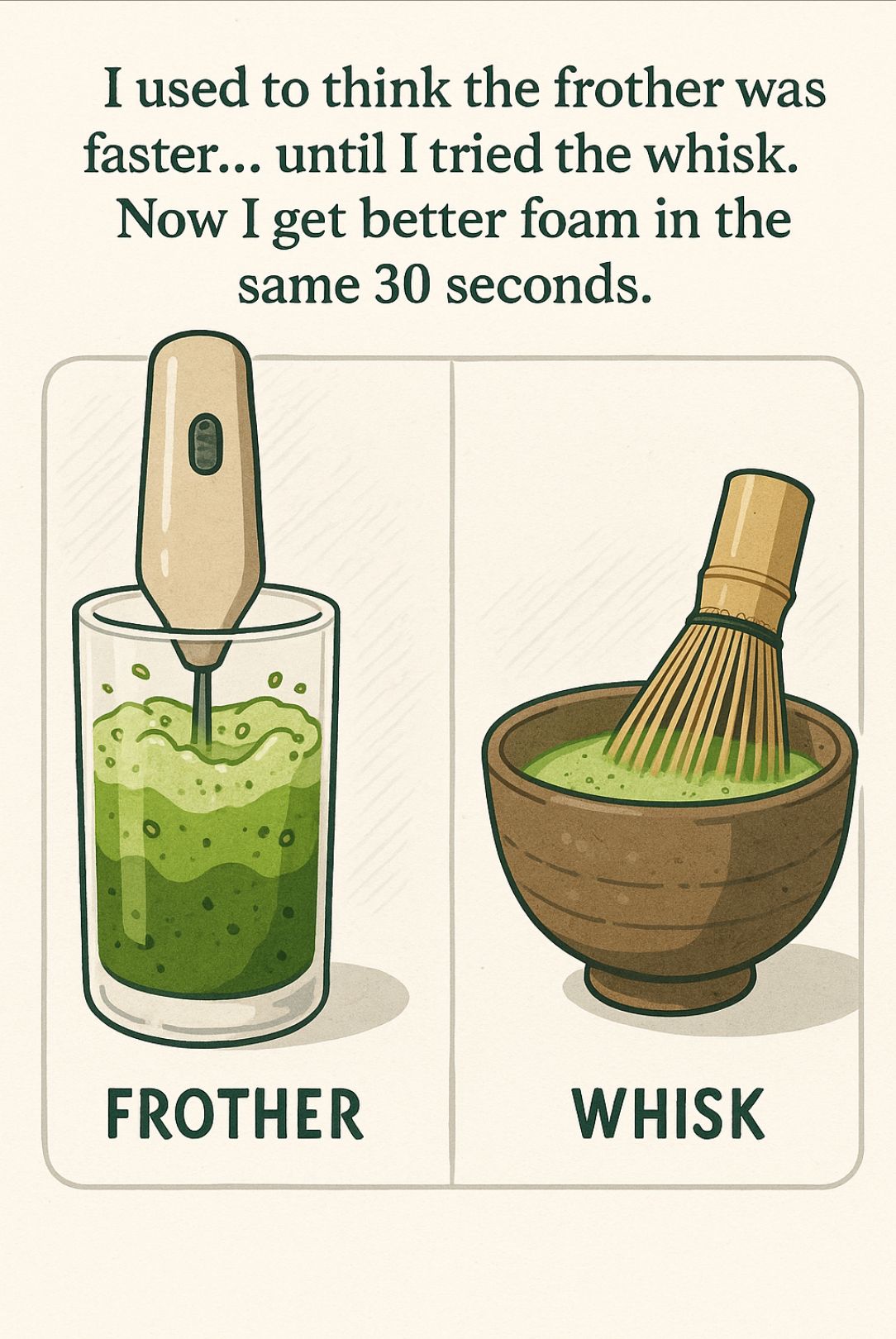
Whisk vs. Frother: The Clear Answer to Better Matcha Utensils
Share
Making a good cup of matcha isn’t just about having the right powder. It’s also about the right tool. Yet for many people — myself included, at the beginning — it’s unclear what that tool should be.
Should you use a bamboo whisk, like in Japanese tea ceremonies? Or is a modern electric frother good enough?
This guide shares what I’ve learned after testing both. My goal is simple: to help you skip the confusion and enjoy better matcha — starting today.
✅ Why You Can Trust Us
We’ve worked with artisanal tea farmers in Japan for over 7 years
Our matcha is always ceremonial-grade and single-origin
We’ve helped over 8,000 customers create a mindful matcha habit
Every product is tested, tasted, and used by our own team — we only sell what we drink
Table of Content
Whisk vs. Frother: The Clear Answer to Better Matcha Utensils
Still not sure whether to use a bamboo whisk or an electric frother for your matcha?
You're not alone — and this article is here to end that confusion for good.
By the end, you'll know exactly:
which tool makes better foam
which one gives smoother flavor
and which one’s worth your time and money
No more guessing. No more wasted matcha. Just a clear answer — and better matcha, starting tomorrow.

Tools That Actually Make a Difference
What Most People Use — And Why It’s Not Working
When I first got into matcha, my instinct was to reach for an electric frother.
It felt modern. Convenient. You press a button, and something green and foamy appears in seconds.
But here's what I found:It rarely tasted right.
The foam was unstable. The flavor was thin. And sometimes... it just felt off.
At first, I blamed the matcha. But over time, I realized — it wasn’t the tea. It was the tool .

“You do not need to understand everything. But you must feel what you’re doing.”
-Sōjūn Ikkyū
Frother vs. Whisk: What Really Happens
“I used to think the frother was faster… until I tried the whisk. Now I get better foam in the same 30 seconds.”

Let’s compare them side by side:
Electric Frother
Spins quickly in one direction
Breaks up the powder with force
Often creates large bubbles or uneven texture
Can overheat the water slightly, dulling the flavor
Result:
Fast, but inconsistent.
Foam is coarse, flavor is unstable, and clumps are common.
Bamboo Whisk (Chasen)
Requires a matcha bowl (chasen works best in wide, open vessels)
Moves in a zigzag, suspending matcha evenly
Creates a silky layer of microfoam
Preserves aroma and taste with gentle movement
Designed specifically for matcha for over 500 years
Result:
Smooth, creamy texture.
Balanced flavor.
Beautiful foam every time.
Why the Whisk Wins
Matcha isn’t like protein powder. It doesn’t dissolve. It floats — and it needs the right kind of motion to stay suspended.
Frothers spin. Whisks lift. That’s the key difference.
Even mid-range matcha tastes better with a whisk. It feels richer, smoother, and more alive.
I visit Japan every year. In Kyoto, where matcha culture runs deep, I’ve never once seen a serious tea shop using an electric frother — even when they’re serving dozens of guests an hour. They whisk. Every time.
Not because it looks good. Because it works.

Common Objections
"But isn’t a whisk harder to use?"
It might feel unfamiliar at first, but it takes less than a minute to learn. Most people get comfortable within two or three tries.
"Isn’t it more expensive?"
Not really. A high-quality whisk costs around $15–20 and can last months with proper care. That’s less than most people spend on one box of matcha.
"I’m not doing a tea ceremony. Do I really need a whisk?"
No ceremony required. But better taste? Smoother texture? A moment of quiet ritual? That’s something you can have every day.

“Even a single bowl of tea contains the entire universe.”
— Dōgen Zenji
Final Verdict
If you care about taste, texture, and getting the most from your matcha — the whisk wins. Every time.
It’s not about being traditional. It’s about using the tool that makes your matcha better.
We’ve tested dozens of tools. Our favorite is hand-crafted, beginner-friendly, and designed to help you create better matcha in under 90 seconds.

The Author: Chang Liu
I’ve worked in food and beverage for over 25 years — sourcing, tasting, building. But matcha is different. It’s not just a drink. For me, it’s a quiet companion. A way to return. A soft light on the path of practice, one cup at a time.
Products Featured In This Blog
Frequently Asked Questions
Do I really need a whisk to make good matcha?
If you want better flavor, texture, and foam — yes. A whisk helps suspend the matcha evenly and creates a smooth, balanced taste.
Can I use a frother if I'm in a rush?
You can. But be aware: the foam will likely be coarse, and the flavor less refined. Some people use a frother for lattes, but even then, whisking first makes a difference
Does a whisk work in any cup?
Whisks work best in wide bowls designed for matcha. Shallow, open vessels allow for better motion and foam formation.
How long does a whisk last?
With gentle use and proper drying, a bamboo whisk can last several months — sometimes longer.
Is this just for people into tea ceremony?
Not at all. No robes or rituals required. Just a better cup of tea.



